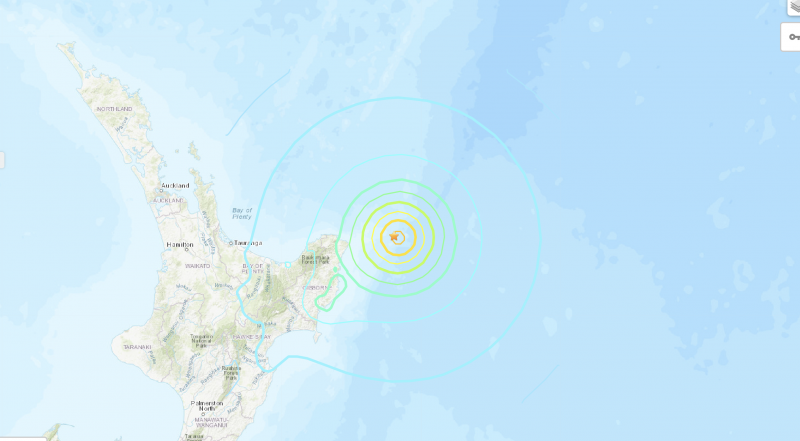
The U.S. Geological Survey is now saying that the large earthquake in New Zealand on March 4, 2021 registered at 7.3 magnitude on the Richter scale. The earthquake struck 147 miles (237 km) northeast of Gisborne, New Zealand, at 2:27 a.m. local time on Saturday, March 5 (8:27 a.m. EST on Friday, March 4). That is about 260 miles (418 km) southeast of Auckland. The earthquake spawned a tsunami warning from the National Emergency Management Agency of New Zealand. The warning lasted approximately two hours, after which people could return to coastal areas, although this organization was still warning people to stay away from “harbors, rivers and estuaries.”
Go to the USGS real-time page for this earthquake
This map shows the areas that can expect strong currents and surges. Strong currents and surges can injure and drown people. People in or near the sea in these areas should move out of the water, off beaches and shore areas and away from harbours, rivers and estuaries. pic.twitter.com/0hYJT5MlAt
— National Emergency Management Agency (@NZcivildefence) March 4, 2021
Based on current scientific advice and information from coastal tsunami gauges there is no longer a threat to land areas. People who have evacuated can now return home.
— National Emergency Management Agency (@NZcivildefence) March 4, 2021
We have issued a NATIONAL ADVISORY: TSUNAMI ACTIVITY following the magnitude 7.3 earthquake near EAST OF THE NORTH ISLAND NEW ZEALAND. We expect New Zealand coastal areas to experience strong and unusual currents and unpredictable surges at the shore
— National Emergency Management Agency (@NZcivildefence) March 4, 2021
The first waves may have reached New Zealand in the areas around East Cape at approximately 3:14 am 5 Mar 2021 NZDT. Tsunami activity will continue for several hours and the threat must be regarded as real until this warning is cancelled. More info at https://t.co/ccVFYR8001
— National Emergency Management Agency (@NZcivildefence) March 4, 2021
from EarthSky https://ift.tt/2O151eO

The U.S. Geological Survey is now saying that the large earthquake in New Zealand on March 4, 2021 registered at 7.3 magnitude on the Richter scale. The earthquake struck 147 miles (237 km) northeast of Gisborne, New Zealand, at 2:27 a.m. local time on Saturday, March 5 (8:27 a.m. EST on Friday, March 4). That is about 260 miles (418 km) southeast of Auckland. The earthquake spawned a tsunami warning from the National Emergency Management Agency of New Zealand. The warning lasted approximately two hours, after which people could return to coastal areas, although this organization was still warning people to stay away from “harbors, rivers and estuaries.”
Go to the USGS real-time page for this earthquake
This map shows the areas that can expect strong currents and surges. Strong currents and surges can injure and drown people. People in or near the sea in these areas should move out of the water, off beaches and shore areas and away from harbours, rivers and estuaries. pic.twitter.com/0hYJT5MlAt
— National Emergency Management Agency (@NZcivildefence) March 4, 2021
Based on current scientific advice and information from coastal tsunami gauges there is no longer a threat to land areas. People who have evacuated can now return home.
— National Emergency Management Agency (@NZcivildefence) March 4, 2021
We have issued a NATIONAL ADVISORY: TSUNAMI ACTIVITY following the magnitude 7.3 earthquake near EAST OF THE NORTH ISLAND NEW ZEALAND. We expect New Zealand coastal areas to experience strong and unusual currents and unpredictable surges at the shore
— National Emergency Management Agency (@NZcivildefence) March 4, 2021
The first waves may have reached New Zealand in the areas around East Cape at approximately 3:14 am 5 Mar 2021 NZDT. Tsunami activity will continue for several hours and the threat must be regarded as real until this warning is cancelled. More info at https://t.co/ccVFYR8001
— National Emergency Management Agency (@NZcivildefence) March 4, 2021
from EarthSky https://ift.tt/2O151eO


Aucun commentaire:
Enregistrer un commentaire